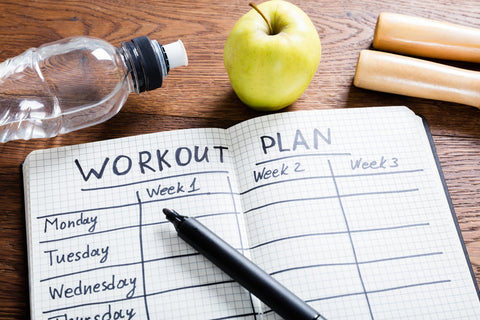Like most sports, we can look at equestrian sports as having seasons. As such, we can break down our yearly calendar into phases: off-season, pre-season, in-season, and post-season (or recovery). Where you live, which discipline you show in, whether you are an amateur or professional, and your typical show schedule will all factor into how long each season will be for you. They can range from a few weeks to months!
This breakdown of the sport into seasons is a well-known training principle called periodization. Each of these phases is broken down into a specific time-frame and requires a different approach to your fitness training. In addition to your equestrian discipline and competition dates, a periodized training plan will also depend on an athlete’s age, experience level, and injury history. However, for all equestrian athletes, the goal is to progress your training through each phase by manipulating some variables to ensure you are prepared both mentally and physically come show season.
Two important variables we will discuss during these seasons are volume and intensity.
- Volume, in strength training terms, means the total number of repetitions, sets, and exercises performed in a session, as well as the frequency of training. For cardiovascular training, it refers to the total distance and/or time of a conditioning program.
- Intensity in strength training relates to the amount of weight or load lifted in relation to your maximal strength, and in cardiovascular training, it is typically measured as a percentage of your maximal heart rate.
Normally, as you progress through each phase or season, your volume and intensity will undulate with the goal that your training will be heavier when you are feeling fresh and energetic, and lighter when you are at an increased risk of fatigue or burnout.
Related: Seven Ways to Become More Deliberate in Your Training
Let’s look at these four phases (or seasons) in more detail to determine how we should manipulate these variables in our fitness training programs.
1. Off-Season:

In your off-season we assume there are no horse shows or events. This is the early preparation phase for both you and your horse for the upcoming show season.
The goal of your fitness program during the off-season is to build both a strength and cardiovascular base, improve your flexibility, mobility, stability, coordination of movement, and to allow the neuromuscular system to adapt to the gradual increase in training.
Your fitness focus during the off-season is on higher volume and lower intensity training. Build your fitness base.
2. Pre-Season:

Your pre-season involves more technique-focused lessons, and perhaps a few warm-up schooling shows. You are gradually putting the final touches on getting you and your horse show-ready.
The goal of your fitness program during the pre-season is to maintain or improve your sport-specific flexibility, mobility, and stability; work on muscles that are involved in the technique of your sport, and incorporate any sport-specific style of strengthening or cardiovascular endurance (take a look back to Part 2 of this series to review what specific muscles you should be focusing on).
The volume and intensity variables start to progress during the pre-season, with your volume being low to moderate, and intensity moving to moderate to high.
3. In-Season:

It’s showtime! The assumption is you will have a busy show schedule, long days, and minimal breaks between shows.
The goal of your fitness program during the in-season is to have all the hard work you put into your workouts during the off-season and pre-season carry you through show season. You should have the strength and endurance to perform show after show without your body breaking down with injury, chronic pain, or excessive fatigue. The hard work you put in during the off-season and pre-season will aid in injury prevention during this phase.
Your workouts will be of low volume during in-season, but the intensity of your workouts will be high. Effective, pre-ride warm-ups, post-ride cool-downs, flexibility, mobility, and nutrition for recovery will all be extremely important during this phase.
4. Post-Season:

Phew! Both you and your horse get a well-deserved break.
The goal of your fitness program during the post-season is to rest and recover, rehabilitate any injuries that may have occurred during the in-season, and to mentally and physically decompress.
Your workouts should not be too formal—allow yourself a break from your regular strength and conditioning program. Think more toward recreational types of activities: go for a walk, swim, cycle, do yoga, or play tennis.
Volume and intensity should be low during the post-season phase. Rest, recover, reflect, and rejuvenate!




